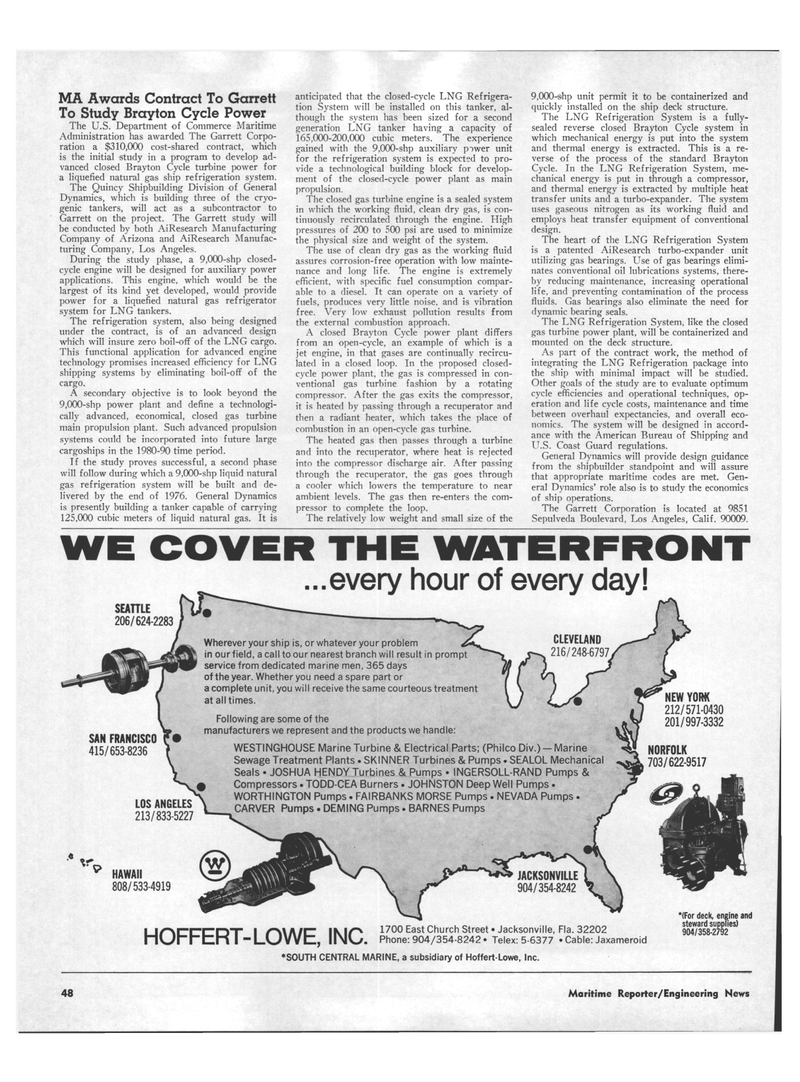
Page 44: of Maritime Reporter Magazine (September 1973)
Read this page in Pdf, Flash or Html5 edition of September 1973 Maritime Reporter Magazine
MA Awards Contract To Garrett
To Study Brayton Cycle Power
The U.S. Department of Commerce Maritime
Administration has awarded The Garrett Corpo- ration a $310,000 cost-shared contract, which is the initial study in a program to develop ad- vanced closed Brayton Cycle turbine power for a liquefied natural gas ship refrigeration system.
The Quincy Shipbuilding Division of General
Dynamics, which is building three of the cryo- genic tankers, will act as a subcontractor to
Garrett on the project. The Garrett study will be conducted by both AiResearch Manufacturing
Company of Arizona and AiResearch Manufac- turing Company, Los Angeles.
During the study phase, a 9,000-shp closed- cycle engine will be designed for auxiliary power applications. This engine, which would be the largest of its kind yet developed, would provide power for a liquefied natural gas refrigerator system for LNG tankers.
The refrigeration system, also being designed under the contract, is of an advanced design which will insure zero boil-off of the LNG cargo.
This functional application for advanced engine technology promises increased efficiency for LNG shipping systems by eliminating boil-off of the cargo.
A secondary objective is to look beyond the 9,000-shp power plant and define a technologi- cally advanced, economical, closed gas turbine main propulsion plant. Such advanced propulsion systems could be incorporated into future large cargoships in the 1980-90 time period.
If the study proves successful, a second phase will follow during which a 9,000-shp liquid natural gas refrigeration system will be built and de- livered by the end of 1976. General Dynamics is presently building a tanker capable of carrying 125,000 cubic meters of liquid natural gas. It is anticipated that the closed-cycle LNG Refrigera- tion System will be installed on this tanker, al- though the system has been sized for a second generation LNG tanker having a capacity of 165,000-200,000 cubic meters. The experience gained with the 9,000-shp auxiliary power unit for the refrigeration system is expected to pro- vide a technological building block for develop- ment of the closed-cycle power plant as main propulsion.
The closed gas turbine engine is a sealed system in which the working fluid, clean dry gas, is con- tinuously recirculated through the engine. High pressures of 200 to 500 psi are used to minimize the physical size and weight of the system.
The use of clean dry gas as the working fluid assures corrosion-free operation with low mainte- nance and long life. The engine is extremely efficient, with specific fuel consumption compar- able to a diesel. It can operate on a variety of fuels, produces very little noise, and is vibration free. Very low exhaust pollution results from the external combustion approach.
A closed Brayton Cycle power plant differs from an open-cycle, an example of which is a jet engine, in that gases are continually recircu- lated in a closed loop. In the proposed closed- cycle power plant, the gas is compressed in con- ventional gas turbine fashion by a rotating compressor. After the gas exits the compressor, it is heated by passing through a recuperator and then a radiant heater, which takes the place of combustion in an open-cycle gas turbine.
The heated gas then passes through a turbine and into the recuperator, where heat is rejected into the compressor discharge air. After passing through the recuperator, the gas goes through a cooler which lowers the temperature to near ambient levels. The gas then re-enters the com- pressor to complete the loop.
The relatively low weight and small size of the 9,000-shp unit permit it to be containerized and quickly installed on the ship deck structure.
The LNG Refrigeration System is a fully- sealed reverse closed Brayton Cycle system in which mechanical energy is put into the system and thermal energy is extracted. This is a re- verse of the process of the standard Brayton
Cycle. In the LNG Refrigeration System, me- chanical energy is put in through a compressor, and thermal energy is extracted by multiple heat transfer units and a turbo-expander. The system uses gaseous nitrogen as its working fluid and employs heat transfer equipment of conventional design.
The heart of the LNG Refrigeration System is a patented AiResearch turbo-expander unit utilizing gas bearings. Use of gas bearings elimi- nates conventional oil lubrications systems, there- by reducing maintenance, increasing operational life, and preventing contamination of the process fluids. Gas bearings also eliminate the need for dynamic bearing seals.
The LNG Refrigeration System, like the closed gas turbine power plant, will be containerized and mounted on the deck structure.
As part of the contract work, the method of integrating the LNG Refrigeration package into the ship with minimal impact will be studied.
Other goals of the study are to evaluate optimum cycle efficiencies and operational techniques, op- eration and life cycle costs, maintenance and time between overhaul expectancies, and overall eco- nomics. The system will be designed in accord- ance with the American Bureau of Shipping and
U.S. Coast Guard regulations.
General Dynamics will provide design guidance from the shipbuilder standpoint and will assure that appropriate maritime codes are met. Gen- eral Dynamics' role also is to study the economics of ship operations.
The Garrett Corporation is located at 9851
Sepulveda Boulevard, Los Angeles, Calif. 90009.
WE COVER THE WATERFRONT ...every hour of every day!
SEATTLE 206/624-2283
SAN FRANCISCO 415/653-8236
LOS ANGELES 213/833-5227
Wherever your ship is, or whatever your problem CLEVELAND in ourfield, a call to our nearest branch will result in prompt *" s r-^ 216/248-6797, service from dedicated marine men, 365 days of the year. Whether you need a spare part or a complete unit, you will receive the same courteous treatment at all times.
Following are some of the manufacturers we represent and the products we handle:
WESTINGHOUSE Marine Turbine & Electrical Parts; (Philco Div.) — Marine
Sewage Treatment Plants • SKINNER Turbines & Pumps • SEALOL Mechanical
Seals • JOSHUA HENDY Turbines & Pumps • INGERSOLL-RAND Pumps &
I Compressors. TODD-CEA Burners. JOHNSTON Deep Well Pumps.
WORTHINGTON Pumps. FAIRBANKS MORSE Pumps . NEVADA Pumps .
CARVER Pumps . DEMING Pumps. BARNES Pumps
NEW YORK 212/571-0430 201/997-3332
NORFOLK 703/622-9517
HAWAII 808/533-4919 JACKSONVILLE 904/354-8242
HOFFERT-LOWE, INC. •SOUTH CENTRAL MARINE, a subsidiary of Hoffert-Lowe, Inc. 1700 East Church Street • Jacksonville, Fla. 32202
Phone: 904/354-8242 • Telex: 5-6377 • Cable: Jaxameroid "(For deck, engine and steward supplies) 904/358-2792 48 Maritime Reporter/Engineering News

 43
43

 45
45
